AMD's Radeon HD 5870: Bringing About the Next Generation Of GPUs
by Ryan Smith on September 23, 2009 9:00 AM EST- Posted in
- GPUs
Eyefinity
Somewhere around 2006 - 2007 ATI was working on the overall specifications for what would eventually turn into the RV870 GPU. These GPUs are designed by combining the views of ATI's engineers with the demands of the developers, end-users and OEMs. In the case of Eyefinity, the initial demand came directly from the OEMs.
ATI was working on the mobile version of its RV870 architecture and realized that it had a number of DisplayPort (DP) outputs at the request of OEMs. The OEMs wanted up to six DP outputs from the GPU, but with only two active at a time. The six came from two for internal panel use (if an OEM wanted to do a dual-monitor notebook, which has happened since), two for external outputs (one DP and one DVI/VGA/HDMI for example), and two for passing through to a docking station. Again, only two had to be active at once so the GPU only had six sets of DP lanes but the display engines to drive two simultaneously.
ATI looked at the effort required to enable all six outputs at the same time and made it so, thus the RV870 GPU can output to a maximum of six displays at the same time. Not all cards support this as you first need to have the requisite number of display outputs on the card itself. The standard Radeon HD 5870 can drive three outputs simultaneously: any combination of the DVI and HDMI ports for up to 2 monitors, and a DisplayPort output independent of DVI/HDMI. Later this year you'll see a version of the card with six mini-DisplayPort outputs for driving six monitors.

It's not just hardware, there's a software component as well. The Radeon HD 5000 series driver allows you to combine all of these display outputs into one single large surface, visible to Windows and your games as a single display with tremendous resolution.
I set up a group of three Dell 24" displays (U2410s). This isn't exactly what Eyefinity was designed for since each display costs $600, but the point is that you could group three $200 1920 x 1080 panels together and potentially have a more immersive gaming experience (for less money) than a single 30" panel.
For our Eyefinity tests I chose to use every single type of output on the card, that's one DVI, one HDMI and one DisplayPort:
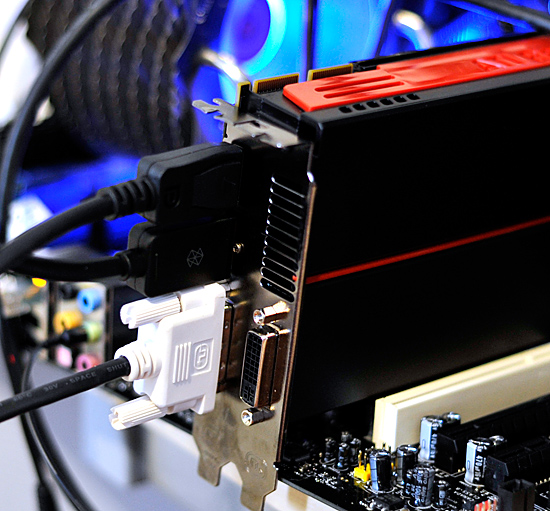
With all three outputs connected, Windows defaults to cloning the display across all monitors. Going into ATI's Catalyst Control Center lets you configure your Eyefinity groups:

With three displays connected I could create a single 1x3 or 3x1 arrangement of displays. I also had the ability to rotate the displays first so they were in portrait mode.

You can create smaller groups, although the ability to do so disappeared after I created my first Eyefinity setup (even after deleting it and trying to recreate it). Once you've selected the type of Eyefinity display you'd like to create, the driver will make a guess as to the arrangement of your panels.

If it guessed correctly, just click Yes and you're good to go. Otherwise ATI has a handy way of determining the location of your monitors:

With the software side taken care of, you now have a Single Large Surface as ATI likes to call it. The display appears as one contiguous panel with a ridiculous resolution to the OS and all applications/games:

Three 24" panels in a row give us 5760 x 1200
The screenshot above should clue you into the first problem with an Eyefinity setup: aspect ratio. While the Windows desktop simply expands to provide you with more screen real estate, some games may not increase how much you can see - they may just stretch the viewport to fill all of the horizontal resolution. The resolution is correctly listed in Batman Arkham Asylum, but the aspect ratio is not (5760:1200 !~ 16:9). In these situations my Eyefinity setup made me feel downright sick; the weird stretching of characters as they moved towards the outer edges of my vision left me feeling ill.
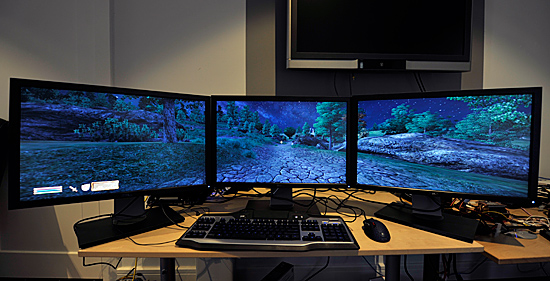
Dispite Oblivion's support for ultra wide aspect ratio gaming, by default the game stretches to occupy all horizontal resolution
Other games have their own quirks. Resident Evil 5 correctly identified the resolution but appeared to maintain a 16:9 aspect ratio without stretching. In other words, while my display was only 1200 pixels high, the game rendered as if it were 3240 pixels high and only fit what it could onto my screens. This resulted in unusable menus and a game that wasn't actually playable once you got into it.
Games with pre-rendered cutscenes generally don't mesh well with Eyefinity either. In fact, anything that's not rendered on the fly tends to only occupy the middle portion of the screens. Game menus are a perfect example of this:
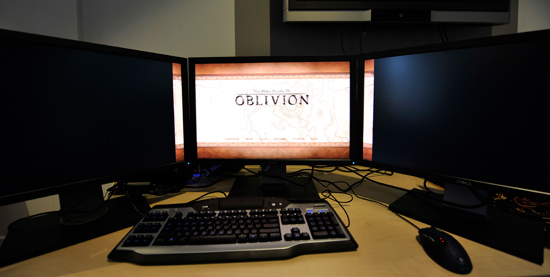
There are other issues with Eyefinity that go beyond just properly taking advantage of the resolution. While the three-monitor setup pictured above is great for games, it's not ideal in Windows. You'd want your main screen to be the one in the center, however since it's a single large display your start menu would actually appear on the leftmost panel. The same applies to games that have a HUD located in the lower left or lower right corners of the display. In Oblivion your health, magic and endurance bars all appear in the lower left, which in the case above means that the far left corner of the left panel is where you have to look for your vitals. Given that each panel is nearly two feet wide, that's a pretty far distance to look.
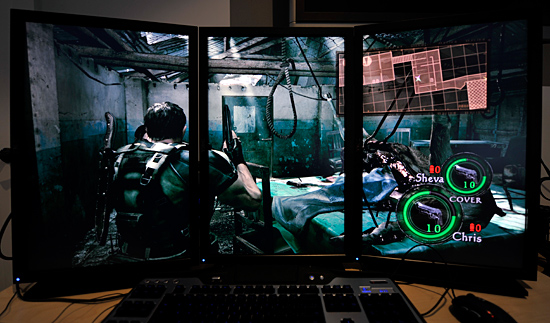
The biggest issue that everyone worried about was bezel thickness hurting the experience. To be honest, bezel thickness was only an issue for me when I oriented the monitors in portrait mode. Sitting close to an array of wide enough panels, the bezel thickness isn't that big of a deal. Which brings me to the next point: immersion.
The game that sold me on Eyefinity was actually one that I don't play: World of Warcraft. The game handled the ultra wide resolution perfectly, it didn't stretch any content, it just expanded my viewport. With the left and right displays tilted inwards slightly, WoW was more immersive. It's not so much that I could see what was going on around me, but that whenever I moved forward I I had the game world in more of my peripheral vision than I usually do. Running through a field felt more like running through a field, since there was more field in my vision. It's the only example where I actually felt like this was the first step towards the holy grail of creating the Holodeck. The effect was pretty impressive, although costly given that I only really attained it in a single game.
Before using Eyefinity for myself I thought I would hate the bezel thickness of the Dell U2410 monitors and I felt that the experience wouldn't be any more engaging. I was wrong on both counts, but I was also wrong to assume that all games would just work perfectly. Out of the four that I tried, only WoW worked flawlessly - the rest either had issues rendering at the unusually wide resolution or simply stretched the content and didn't give me as much additional viewspace to really make the feature useful. Will this all change given that in six months ATI's entire graphics lineup will support three displays? I'd say that's more than likely. The last company to attempt something similar was Matrox and it unfortunately didn't have the graphics horsepower to back it up.
The Radeon HD 5870 itself is fast enough to render many games at 5760 x 1200 even at full detail settings. I managed 48 fps in World of Warcraft and a staggering 66 fps in Batman Arkham Asylum without AA enabled. It's absolutely playable.
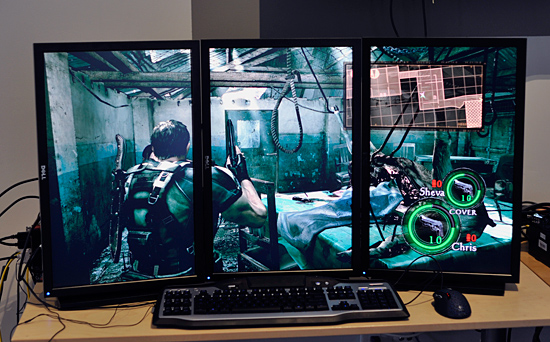










327 Comments
View All Comments
Zool - Friday, September 25, 2009 - link
"The GT300 is going to blow this 5870 away - the stats themselves show it, and betting otherwise is a bad joke, and if sense is still about, you know it as well."If not than it would be a sad day for nvidia after more than 2 years of nothing.
But the 5870 can still blow away any other card around. With DX11 fixed tesselators in pipeline and compute shader postprocessing (which will finaly tax the 1600 stream procesors)it will look much better than curent dx9. The main advantage of this card is the dx11 which of course nvidia doesnt hawe. And maybe the dewelopers will finaly optimize for the ati vector architecture if there isnt any other way meant to be played(payed) :).
Actualy nvidia couldnt shrink the last gen to 40nm with its odd high frequency scalar shaders (which means much more leakage) so i wouldent expect much more from nvidia than double the stats and make dx11 either.
SiliconDoc - Friday, September 25, 2009 - link
Here more new NVidia cards, so the fasle 2 years complaint is fixzling fast.Why this hasn't been mentioned here at anadtech yet I'm not sure, but of course...
http://www.fudzilla.com/content/view/15698/1/">http://www.fudzilla.com/content/view/15698/1/
Gigabyte jumps the gun with 40nm
According to our info, Nvidia's GT 220, 40nm GT216-300 GPU, will be officially announced in about three weeks time.
The Gigabyte GT 220 works at 720MHz for the core and comes with 1GB of GDDR3 memory clocked at 1600MHz and paired up with a 128-bit memory interface. It has 48 stream processors with a shader clock set at 1568MHz.
--
See, there's a picture as well. So, it's not like nothing has been going on. It's also not "a panicky response to regain attention" - it is the natural progression of movement to newer cores and smaller nm processes, and those things take time, but NOT the two years plus ideas that spread around....
SiliconDoc - Friday, September 25, 2009 - link
The GT200 was released on June 16th and June17th, 2008, definitely not more than 2 years ago, but less.The 285 (nm die shrink) on January 15th, 2009, less than 1 year ago.
The 250 on March 3rd this year, though I wouldn't argue you not wanting to count that.
I really don't think I should have to state that you are so far off the mark, it is you, not I, that might heal with correction.
Next, others here, the article itself, and the ati fans themselves won't even claim the 5870 blows away every other card, so that statement you made is wrong, as well.
You could say every other single core card - no problem.
Let's hope the game scenes do look much better, that would be wonderful, and a fine selling point for W7 and DX11 (and this casrd if it is, or remains, the sole producer of your claim).
I suggest you check around, the DX11 patch for Battleforge is out, so maybe you can find confirmation of your "better looking" games.
" Actualy nvidia couldnt shrink the last gen to 40nm with its odd high frequency scalar shaders "
I believe that is also wrong, as they are doing so for mobile.
What is true is ATI was the ginea pig for 40nm, and you see, their yeilds are poor, while NVidia, breaking in later, has had good yeilds on the GT300, as stated by - Nvidia directly, after ATI made up and spread lies about 9 or less per wafer. (that link is here, I already posted it)
---
If Nvidia's card doubles performance of the 285, twice the frames at the same reso and settings, I will be surprised, but the talk is, that or more. The stats leaked make that a possibility. The new MIMD may be something else, I read 6x-15x the old performance in certain core areas.
What Nvidia is getting ready to release is actually EXCITING, is easily described as revolutionary for videocards, so yes, a flop would be a very sad day for all of us. I find it highly unlikely, near impossible, the silicon is already being produced.
The only question yet is how much better.
Zool - Friday, September 25, 2009 - link
I want to note also that the 5870 is hard to find which means the 40nm tsmc is still far from the last gen 55nm. After they manage it to get on the 4800 level the prices will be different. And maybe the gt300 is still far away.mapesdhs - Friday, September 25, 2009 - link
Is there any posting moderation here? Some of the flame/troll posts
are getting ridiculous. The same thing is happening on toms these days.
Jarred, best not to reply IMO. I don't think you're ever going to get
a logical response. Such posts are not made with the intent of having
a rational discussion. Remember, as Bradbury once said, it's a sad
fact of nature that half the population have got to be below average. :D
Ian.
Zool - Friday, September 25, 2009 - link
I would like to see some more tests on power load. Actualy i dont think there are too many people with 2560*1600 displays. There are still plenty people with much lower resolutions like 1680*1050 and play with max imagequality. With VSync on if u reduce 200fps to 60fps u get much less gpu temps and also power load.(things like furmark are miles away from real world) On LCD there is no need to turn it off just if u benchmark and want more fps. I would like to see more power load tests with diferent resolutions and Vsync on.(And of course not with crysis)Also some antialiasing tests, the adaptive antialiasing on 5800 is now much faster i read.And the FSAA is of course blurry, it was always so. If u render the image in 5120*3200 on your 2560*1600 display and than it combines the quad pixels it will seems like its litle washed out. Also in those resolution even the highress textures will begin to pixalate even in closeup so the combined quad pixels wont resemble the original. Without higher details in game the FSAA in high resolution will just smooth the image even more. Actualy it always worked this way even on my gf4800.
SiliconDoc - Friday, September 25, 2009 - link
PS - a good friend of mine has an ATI HD2900 pro with 320 shaders (a strange one not generally listed anywhere) that he bought around the time I was showing him around the egg cards and I bought an ATI card as well.Well, he's a flight simmer, and it has done quite well for him for a about a year, although in his former Dell board it was LOCKED at 500mhz 503mem 2d and 3d, no matter what utility was tried, and the only driver that worked was the CD that came with it.
Next on a 570 sli board he got a bit of relief, an with 35 various installs or so, he could sometimes get 3d clocks to work.
Even with all that, it performed quite admirably for the strange FS9 not being an NVidia card.
Just the other day, on his new P45 triple pci-e slot, after 1-2 months running, another friend suggested he give OCCT a go, and he asked what is good for stability (since he made 1600fsb and an impressive E4500 (conroe) 200x11/2200 stock to a 400x8/ 3200mhz processor overclock for the past week or two). "Ten minutes is ok an hour is great" was the response.
Well, that HD2900pro and OCCT didn't like eachother much either - and DOWN went the system, 30 seconds in, cooking that power supply !
--- LOL ---
Now that just goes to show you that hiding this problem with the 4870 and 4890 for so many months, not a peep here... is just not good for end users...
---
Thanks a lot tight lipped "nothing is wrong with ATI cards" red fans. Just wonderful.
---
He had another PS and everything else is OK
, and to be quite honest and frank and fair as I near always am, that HD2900pro still does pretty darn good for his flight simming ( and a few FPS we all play sometimes) and he has upgraded EVERYTHING else already at least once, so on that card, well done for ATI. (well depsite the drivcer issues, 3d mhz issues, etc)
Oh, and he also has a VERY NICE 'oc on it now(P45 board) - from 600/800 core/mem 3D to 800/1000, and 2d is 500/503, so that's quite impressive.
SiliconDoc - Wednesday, September 30, 2009 - link
Ahh, isn't that typical, the 3 or 4 commenters raving for ati "go dead silent" on this furmark and OCCT issue.--
"It's ok we never mentioned it for a year plus as we guarded our red fan inner child."
(Ed. note: We "heard" nvidia has a similar implementation")
WHATEVER THAT MEANS !
---
I just saw (somewhere else) another red fanatic bloviating about his 5870 only getting up to 76C in Furmark. ROFLMAO
--
Aww, the poor schmuck didn't know the VRM's were getting cut back and it was getting throttled from the new "don't have a heat explosion" tiny wattage crammed hot running ati core.
SiliconDoc - Friday, September 25, 2009 - link
Well you brought to mind another sore spot for me.In the article, when the 4870 and 4890 FAIL furmark and OCCT, we are suddenly told, after this many MONTHS, that a blocking implementation in ati driver version 9.2 was put forth by ATI, so their cards wouldn't blow to bits on furmark and OCCT.
I for one find that ABSOLUTELY AMAZING that this important information took this long to actually surface at red central - or rather, I find it all too expected, given the glaring bias, ever present.
Now, the REASON this information finally came forth, other thanb the epic fail, is BECAUSE the 5870 has a "new technology" and no red fan site can possibly pass up bragging about something new in a red core.
So the brag goes on, how protection bits in the 5870 core THROTTLE BACK the VRM's when heat issues arise, hence allowing for cheap VRM's & or heat dissipation issues to divert disaster.
That's wonderful, we finally find out about ANOTHER 4870 4980 HEAT ISSUE, and driver hack by ATI, and a failure to RUN THE COMMON BENCHMARKS we have all used, this late in the game.
I do have to say, the closed mouthed rabid foam contained red fans are to appluaded for their collective silence over this course of time.
Now, further bias revealed in tha article - the EDITOR makes sure to chime in, and notes ~"we have heard Nvidia has a similar thing".
What exactly that similar thing is, and whom the Editor supposedly heard it from, is never made clear.
Nonetheless, it is a hearty excuse and edit for, and in favor of, EXCUSING ATI's FAILURES.
Nonetheless, ALL the nvidia cards passed all the tests, and were 75% in number to the good cooler than the ATI's that were- ATI all at 88C-90C, but, of course, the review said blandly in a whitewash, blaming BOTH competitors nvidia and ati - "temps were all over the place" (on load).
(The winning card GTX295 @ 90C, and 8800GT noted 92C *at MUCH reduced case heat and power consumption, hence INVALID as comparison)
Although certain to mention the GT8800 at 92C, no mention of the 66C GTX250 or GTX260 winners, just the GTX275 @ 75C, since that was less of a MAJOR EMBARRASSMENT for the ATI heat load monsters !
Now THERE'S A REAL MONSTER - AND THAT'S ALL OF THE ATI CARDS TESTED IN THIS REVIEW ! Not just the winning nvidia, while the others that matter (can beat 5870 in sli or otherwise) hung 24C to 14C lower under load.
So, after all that, we have ANOTHER BIAS, GLARING BIAS - the review states " there are no games we know of, nor any we could find, that cause this 5870 heat VRM throttling to occur".
In other words, we are to believe, it was done in the core, just for Furmark and OCCT, or, that it was done as precaution and would NEVER come into play, yes, rest assured, it just won't HAPPEN in the midst of a heavy firefight when your trigger finger is going 1,000mph...
So, I found that just CLASSIC for this place. Here is another massive heat issue, revealed for the first time for 4870 and 4890 months and months and months late, then the 5870 is given THE GOLDEN EXCUSE and massive pass, as that heat reducing VRM cooling voltage cutting framerate lowering safety feature "just won't kick in on any games".
ROFL
I just can't help it, it's just so dang typical.
DigitalFreak - Friday, September 25, 2009 - link
Looks like SnakeOil has yet ANOTHER account.